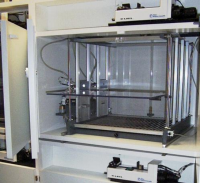








An operant conditioning chamber is a laboratory apparatus used in the experimental analysis of animal behavior. It was invented by Skinner while he was a graduate student at Harvard University, where he received the doctorate in 1931. As used by Skinner, the box had a lever (for rats) or a disk in one wall (for pigeons). A press on this "manipulandum" could deliver food to the animal through an opening in the wall, and responses reinforced in this way increased in frequency. By controlling this reinforcement together with discriminative stimuli such as lights and tones, or punishments such as electric shocks, experimenters have used the operant box to study a wide variety of topics, including schedules of reinforcement, discriminative control, delayed response ("memory"), punishment, and so on. By channeling research in these directions, the operant conditioning chamber has had a huge influence on course of research in animal learning and its applications. It enabled great progress on problems that could be studied by the measuring the rate, probability, or force of a simple, repeatable response. However, it discouraged the study of behavioral processes not easily conceptualized in such terms - spatial learning, in particular, which is now studied in quite different ways, for example by the use of the water maze.
Purpose of Operant conditioning chamber
An operant conditioning chamber permits experimenters to study behavior conditioning (training) by teaching a subject animal to perform certain actions (like pressing a lever) in response to specific stimuli, such as a light or sound signal. When the subject correctly performs the behavior, the chamber mechanism delivers food or another reward. In some cases, the mechanism delivers a punishment for incorrect or missing responses. For instance, to test how operant conditioning works for certain invertebrates, such as fruit flies, psychologists use a device known as a "heat box". Essentially this takes up the same form as the Skinner box, but the box is composed of two sides: one side that can undergo temperature change and the other that does not. As soon as the invertebrate crosses over to the side that can undergo a temperature change, the area is heated up. Eventually, the invertebrate will be conditioned to stay on one side of a heat box, or more specifically the side that does not undergo a temperature change. This goes to the extent that even when the temperature is turned to its lowest point, the fruit fly will still refrain from approaching that area of the heat box.These types of apparatuses allow experimenters to perform studies in conditioning and training through reward/punishment mechanisms.